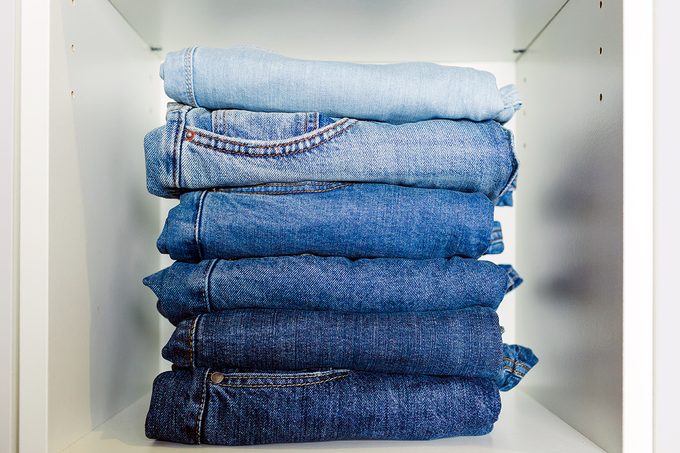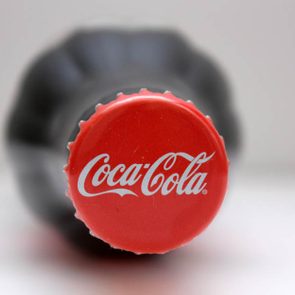From ancient dyes to chemical breakthroughs, here's why jeans were always meant to be blue

Here’s the Real Reason Most Jeans Are Blue

The first time I ever really paid attention to the color of my jeans was while sitting in urgent care, panicking because my hands had turned a sickly blue. Naturally, I assumed I was oxygen-deprived from some rare, terrifying illness. “Do you normally sit with your hands clasped between your legs?” the nurse asked. I did. She gently pointed out that the blue tint wasn’t a sign of imminent doom—it was just the dye from my new jeans rubbing off on my skin. I’ve never felt so stupid and so relieved at the same time. But it did leave me wondering: Why are jeans blue, anyway?
Spoiler alert: It’s not because blue matches everything (though it kinda does). “Blue jeans are blue because of the unique dye used,” says textile scientist and denim expert Melanie DiSalvo. This dye, she explains, is “very special” because it doesn’t behave like any other type of fabric dye—basically making it the Beyoncé of the textile world. And the reason your jeans are blue has less to do with fashion and more to do with historical facts, a lot of dirt and one very clingy molecule that refuses to act normal. (Am I suddenly relating so hard to a dye? Yes.)
I spoke with DiSalvo, fashion historian and author Robert Ossant, and Amanda Massi, a celebrity stylist with an MFA in fashion design, to get all the juicy denim details. Read on to find out exactly what that dye is, how it works, and the surprisingly dramatic origin story of your favorite pants.
Get Reader’s Digest’s Read Up newsletter for more common curiosities, humor, travel, tech, cleaning and fun facts all week long.
Why are jeans blue?
Most people think blue jeans are blue because … well, they’ve always been blue. Denim is even used as a synonym for a certain shade of blue. But there’s actual science (and centuries of global trade) behind the color choice.
A very unique kind of dye
“The reason most jeans are blue is deeply rooted in the fabric’s 19th-century origins,” Massi says. “When Levi Strauss and Jacob Davis patented their riveted denim trousers in 1873, they chose a cotton fabric dyed with indigo—the deep, rich blue hue that has become synonymous with jeans.”
Why indigo? Because it’s not like other dyes. “Most dyes penetrate the fibers, but indigo wraps around the yarn,” DiSalvo says. “It can then be worn off, which is what gives the fade effect on jeans over time.” This unique “coating” property of the dye gives jeans their signature look and is why your favorite pair gets more flattering with every wear, Massi says.
Its ability to hide dirt
There’s a practical side to this too. “Historically, blue was a practical choice,” Massi says. “Indigo dye is dark enough to help mask stains and wear, a huge plus for laborers who couldn’t change clothes frequently.” This combo makes blue denim both durable and forgiving—and the natural choice for pants meant for heavy physical work.
So if you’ve ever wiped your hands on your thighs and called it “fine,” you’re not gross. You’re just upholding a sacred denim tradition.
Have jeans always been blue?
Mostly. People have been obsessed with indigo for literally thousands of years. “Indigo is one of the oldest-known dyes, used for over 4,000 years, all over the ancient world,” says Ossant, who writes about historical denim trends. “In fact, the dye was a major export from India, and the Greek term indikon, meaning ‘from India,’ is the root of the modern word indigo.”
At first, blue used to be reserved for Very Important Art. “In Europe, blue pigments were historically rare and expensive,” Ossant explains. “The earliest blue paints were made using lapis lazuli, a semiprecious stone imported from Afghanistan. Ground into a pigment known as ultramarine, it was used in religious painting, especially for the robes of the Virgin Mary.”
This association made blue symbolic of hard work, humility and purity—basically everything jeans came to represent. When people moved to the indigo plant to get the signature color, “this association established blue as a symbol of humility and self-sacrifice, ideas later tied to physical labor and the American dream,” says Ossant.
What cemented denim as the jeans color of choice?

Aside from the symbolism and recognition factor, Massi says blue jeans took off thanks to that indigo dye—and not just because of the color but because of what it could do. Levi Strauss tried other shades, but blue always won out. Why? It looked great dirty, faded like a boss and—thanks to a chemical breakthrough—eventually got way cheaper.
But one final innovation ensured the commercial viability of Levi’s jeans and ensured their historic longevity, Ossant says. When Levi Strauss began making jeans, natural indigo was one of the most expensive and labor-intensive dyes out there. He experimented with other colors but kept coming back to blue because it was the crowd favorite. Then came the game-changer: synthetic indigo dye, invented in the 1890s. “This made it easier and cheaper to manufacture blue jeans and ensured their place in history,” Ossant says.
What color is denim naturally?
It’s not blue. It’s beige—like, oatmeal-beige.
Denim is a cotton fabric that originated in France. It’s true—one of the icons of American history isn’t American. Sacrilege, I know. But while Levi Strauss gets the credit for inventing jeans as we know them, the actual fabric dates back to 16th-century France.
“The material we now call denim was originally made in the city of Nîmes,” Ossant says. “The André family created a durable cotton canvas there, and it became known as ‘serge de Nîmes’—literally, denim.” From there, it traveled to Genoa, Italy, where it was dyed blue and used in sails and work clothes. The French called it “bleu de Gênes.” Say it with a California drawl and you get … blue jeans.
Your entire wardrobe has been a European pun this whole time.
How do you get other denim colors?
You can get other colors by knowing your chemistry. “Sulfur, iron and a few other natural elements can be added to the indigo to manipulate its color, making it more green, red or black,” DiSalvo says. White jeans are also a popular and timeless option, and their color is derived from denim’s naturally lighter color.
But at the end of the day, nothing beats classic blue. Today’s designers still nod to those indigo roots, but they aren’t afraid to get creative. “The ultimate shade—whether it’s a raw, inky indigo or a pale, sun-bleached blue—is determined by a designer or brand’s vision, the desired aesthetic and trends in the fashion world, often with input from textile experts and specialist dye houses,” Massi explains.
So, yes, a lot of thought goes into even your distressed boyfriend jeans with the factory-fresh holes—and owe their lives to 19th-century miners and some pretty intense chemistry. (Though those miners would probably be horrified to know that we now pay extra for jeans that come pre-destroyed.)
About the experts
|
Why trust us
At Reader’s Digest, we’re committed to producing high-quality content by writers with expertise and experience in their field in consultation with relevant, qualified experts. We rely on reputable primary sources, including government and professional organizations and academic institutions as well as our writers’ personal experiences where appropriate. For this piece on why jeans are blue, Charlotte Hilton Andersen tapped her experience as a longtime journalist who specializes in common curiosities, etiquette and communication for Reader’s Digest. We verify all facts and data, back them with credible sourcing and revisit them over time to ensure they remain accurate and up to date. Read more about our team, our contributors and our editorial policies.
Sources:
- Melanie DiSalvo, textile scientist and denim expert; phone interview, June 10, 2025
- Amanda Massi, celebrity stylist with an MFA in fashion design; phone interview, June 11, 2025
- Robert Ossant, fashion historian and author of The Art of Couture Embroidery: The Secrets of Runway Design; email interview, June 14, 2025


















